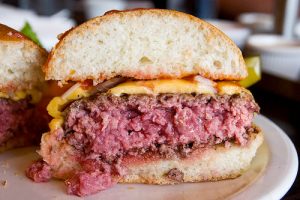Cornwall Live reports the Meat Counter is one of those burger joints that are so much more than that.
 Located in Arwenack Street in Falmouth, the stylish American-style eatery known for its homemade burgers and chili fries has carved a name for itself on the culinary scene in the town and beyond.
Located in Arwenack Street in Falmouth, the stylish American-style eatery known for its homemade burgers and chili fries has carved a name for itself on the culinary scene in the town and beyond.
There is an extensive menu to choose from including the £13 M.I.L.F. – a burger, pulled pork and chicken layered extravaganza with a fried Jalapeno on top.
Alongside its signature dishes, The Meat Counter offers a selection of American delicacies such as the ultimate bulldog (hot dog), local steaks and chips with all the trimmings.
It also has fine vegetarian options including The Filthy Shroomburger and Spiced Chickpea Burger.
It opened three years ago, employs 10 staff and has consistently received high reviews from punters, with 223 ‘excellent’ or ‘very good’ reviews out of 262 on TripAdvisor.
However the Meat Counter was one of six restaurants in the Duchy to receive a zero hygiene score rating from Cornwall Council food inspectors following a visit in July.
The note from Cornwall Council inspectors was that the venue needed to improve its handling of food including preparation, cooking, re-heating, cooling and storage, along with a major improvement of the general cleanliness and condition of its facilities and building.
The zero rating also came with a ‘major improvement necessary’ warning for the management of food safety.
When Cornwall Live revealed the list of the 75 worst-rated restaurants in Cornwall, Martyn Peters, owner of the Meat Counter, said the score was by no means a reflection of the kinds of “kitchen nightmares” documented at other places.
 He said that if issues such as cross-contamination or out-of-date food had been a factor in the company’s score, the kitchen would have been shut down immediately instead of simply being given the lowest rating.
He said that if issues such as cross-contamination or out-of-date food had been a factor in the company’s score, the kitchen would have been shut down immediately instead of simply being given the lowest rating.
He added: “On the contrary, the vast majority of the issues raised during that first visit were rectified within 48 hours, and we have continued to trade ever since.”
Mr Peters said the hygiene scoring rating from council food inspectors could do with greater transparency.
A restaurant, especially in an old building, can be penalised for having small cracks in the floor tiles or for its bins not being collected on the day of the inspection even though it is out of its control.
Structural faults inherent to old buildings can also play against a restaurant and may involve expensive work to fix.
Mr Peters added: “Any business worth its salt takes the condemnation of a zero rating very seriously and we’ve been working closely with our environmental health officer to address the issues raised during her first inspection.”
Assessment of risk communication about undercooked hamburgers by restaurant servers
Ellen M. Thomas, RTI International; Andrew Binder, Anne McLaughlin, Lee-Ann Jaykus, Dana Hanson, and Benjamin Chapman, North Carolina State University; and Doug Powell, powellfoodsafety.com
Journal of Food Protection
DOI: 10.4315/0362-028X.JFP-16-065
According to the U.S. Food and Drug Administration 2013 Model Food Code, it is the duty of a food establishment to disclose and remind consumers of risk when ordering undercooked food such as ground beef. The purpose of this study was to explore actual risk communication activities of food establishment servers. Secret shoppers visited restaurants (n=265) in seven geographic locations across the U.S., ordered medium rare burgers, and collected and coded risk information from chain and independent restaurant menus and from server responses. The majority of servers reported an unreliable method of doneness (77%) or other incorrect information (66%) related to burger doneness and safety. These results indicate major gaps in server knowledge and risk communication, and the current risk communication language in the Model Food Code does not sufficiently fill these gaps. Furthermore, should servers even be acting as risk communicators? There are numerous challenges associated with this practice including high turnover rates, limited education, and the high stress environment based on pleasing a customer. If it is determined that servers should be risk communicators, food establishment staff should be adequately equipped with consumer advisory messages that are accurate, audience-appropriate, and delivered in a professional manner so as to help their customers make more informed food safety decisions.
 Emma Young of The Sydney Morning Herald reports that Woolworths at Madeley’s Kingsway City must cough up $100,000-plus after numerous public health offences.
Emma Young of The Sydney Morning Herald reports that Woolworths at Madeley’s Kingsway City must cough up $100,000-plus after numerous public health offences.











